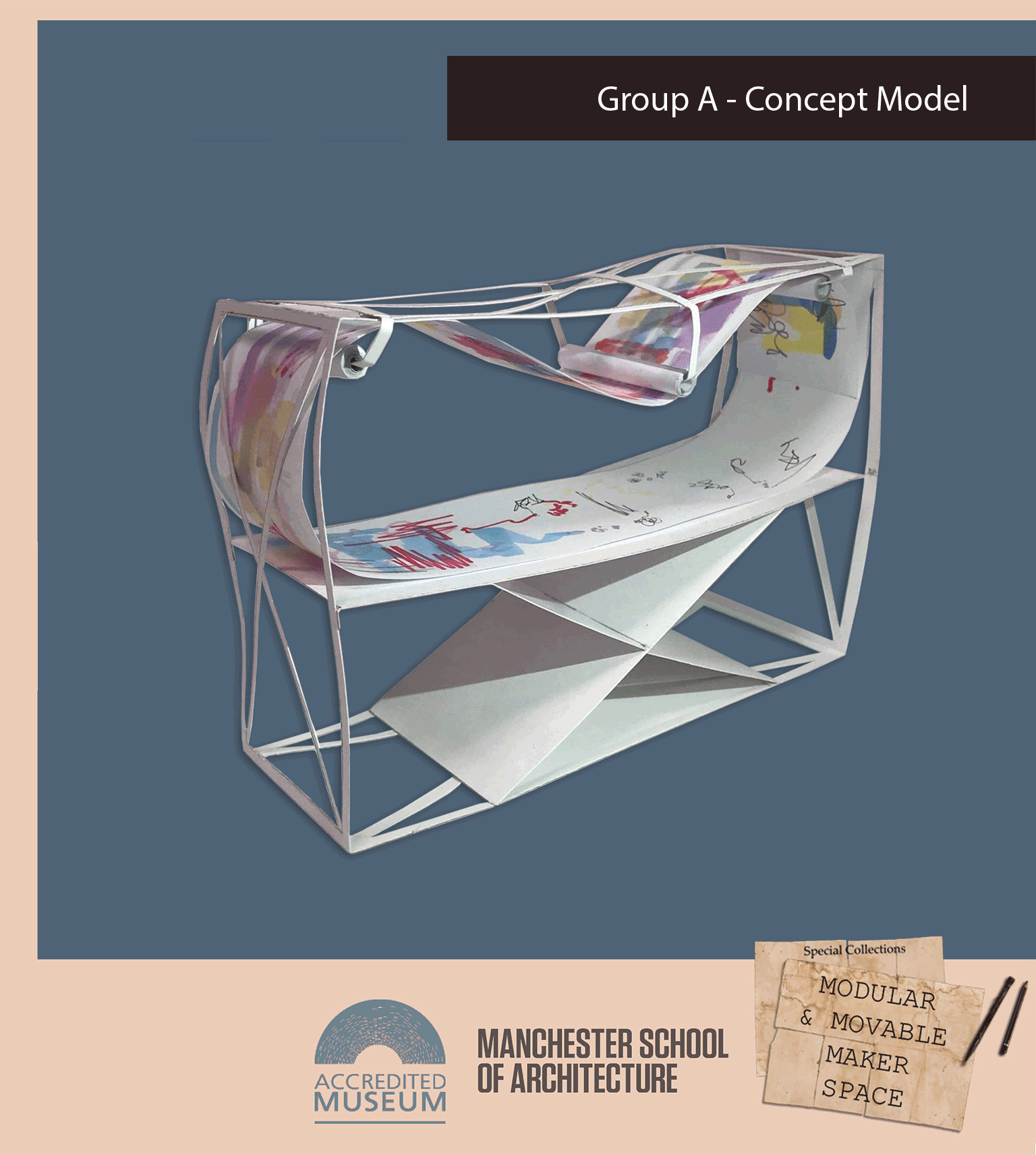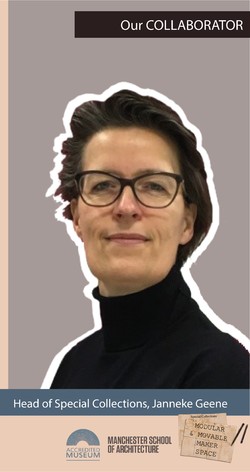Friday 05/04/2019
10:00
We had our final presentation with our client Janneke Geene, where Team A explained the Final design development. A drawing package was generated for the concept and was handed over to Janneke. We also created a poster, as seen above, presenting the idea, final design, details and pictures of the model. This can be further used as a brief for presenting it to prospective contractors.
Posted 6 May 2019 13:12
THURSDAY 24/03/2019
16:00
The model displayed above is the 1:200 scale concept model done by Group A. They created a makerspace which has the look of an old paper-printing machine and looks very industrial. But, the paper loop rolled along the model through the cylinders is for the public to explore ideas, create vibrant, colourful doodles and thereby giving a play of contrast of the structure and the paper.
Posted 3 Apr 2019 12:15
We would like to formally introduce our collaborator Janneke Geene who is the Head of Special Collections. She joined the team in November 2017. She formerly worked at the People's History Museum for almost 16 years. She has also worked with Manchester Museum and the Science+Industry Museum in Manchester.
Janneke aims to re-position the Special Collections as the University Museum it really is and give it the pride of place on campus.
Through EVENTS she aims to develop a makerspace where visitors who have been inspired by the Special Collections can have a go at being creative themselves.
Posted 1 Apr 2019 11:40

Monday 25/03/2019
11:00
Jane Pendlebury from the Special Collections team was kind enough to educate us about The Special Collections Reading Room which is a place that holds a large treasure of books, each one having its own history. Some of the books range back to the 18-19th century. These books are classified into three sections:
1) ARTISTS' BOOKS - These books are the Artists' works and are collected by the gallery or are donated by the Artist himself. They are a piece of art in itself.
2) BOOK DESIGN - This section mainly contains book bearing information about designing books, layouts, typography, structure, etc.
3) CHILDREN'S BOOKS - Some of them ranging back to the 19th century, these books are filled with a variety of children's storybooks having the minute, delicate, interesting, bright and colourful illustrations and children's stories. A lot of these books were written by the famous children story-writer, Beatrix Potter.
All of us enjoyed our time at the reading room skimming through all these books and getting inspired, also, mainly understanding in what ways can we display such delicate artworks in our Makerspace.
Posted 26 Mar 2019 04:13

Monday 25/03/2019
14:30
Whitworth Art Gallery located on Oxford Road in Manchester is a part of the University of Manchester. It currently hosts eight various small and large scale exhibitions. We saw all the exhibitions, but for the makerspace idea, we found the 'Bodies of Colour: Breaking with stereotypes in the wallpaper collection' exhibition to very suitable to take inspiration from.
The 'Bodies of Colour: Breaking with stereotypes in the wallpaper collection' exhibition uses the Whitworth’s extensive and significant wallpaper collection to focus on how imperial attitudes to people are reflected in wallpaper.
The wallpapers in this exhibition were designed in Western Europe (and a few in America) but the inspiration for the patterns comes from across the globe. The popularity of wallpaper grew through the 18th to 20th centuries, at the same time as the rapid expansion of the British Empire; the collection spans these three centuries.
The exhibition contains a mix of commercially available wallpapers as well as wallpapers made by artists.
Posted 26 Mar 2019 03:14
Monday 25/03/2019
10:00
We visited the site on our way to MMU Special Collections. Our site is actually the lobby space located right outside the main entrance to Special Collections. We introduced BA1 and BA2 students with site opportunities and constraints. After discussion, the following points were observed:
1)ACCESSIBILITY - As seen above in the pictures, the site has two doorways on either shorter sides and one doorway on the longer side. Hence, we addressed this point to understand the public movement in the space during general use and fire evacuation.
2) RELOCATION - As seen on the front wall, there are certain display items in shelves which can be relocated inside the main gallery and the space can be opened out if needed.
3) MODIFICATION - Altering the current formal look of the space into a more vibrant, welcoming look so as to bring in more students to utilize the makerspace.
Posted 26 Mar 2019 01:15

'Drawing the Modern' draws on the archive of Gordon Hodkinson (1928-2018), a student of architecture at Manchester Municipal School of Art in the 1940s-1950s. The exhibition explores
post-war architectural education through a selection of Hodkinson's drawings including sketches, gouache rendered plans and construction details, as well as project briefs and lecture notes.
In Manchester, in the mid-twentieth century, there were two schools of architecture. One was based at Owens College (The University of Manchester) and the other at Manchester Municipal School of Art. At the Municipal School, under the direction of Head of Architecture Douglas Jones, modernism was central to teaching and design in architecture.
It was in this modern school of architecture that Gordon Hodkinson studied between 1944 and 1951. He was sponsored by H.T. Seward of the architectural firm Cruickshank & Seward and went on to spend his whole career with the firm. He was involved with the Ferranti factory in Wythenshawe and the nearby headquarters for the Renold Chain Company. Gordon was also project architect for the Reynold Building on the former UMIST campus, the city's best group of twentieth-century buildings.
This is the first public exhibition of work from Hodkinson's archive and that of Cruikshank & Seward. It has been curated by Dr. Richard Brook, Reader in Architecture at Manchester School of Architecture, Manchester Metropolitan University.
https://www.specialcollections.mmu.ac.uk/exhibitions.php
Posted 18 Feb 2019 00:59

What does the Special Collections offer?
STUDY & LEARN
Special Collections offers inspiration to students in their studies. The Special Collections’ reading room is open from 10 am until 4 pm, Monday to Friday. The Book Design and Children's collections can be accessed without an appointment. One can contact the Special Collections team in advance to make arrangements to view other material in the collections or if one is not a student or member of staff at Manchester Metropolitan University.
TEACH
The collections can also be used in teaching to groups of up to 20 people. In addition to this, the collections offer access to their publications and catalogs from where learning material and educational resources may be purchased. It also gives an insight into the archival collection, one of which is the North West Film Archive, where viewing facilities are available for individuals as well as groups for teaching, research, and screenings.
EXHIBIT
The Special Collections has a changing programme of exhibitions often accompanied by lectures and tours. The team also host meetings and events where the displays of material from the collections provide an inspirational and attractive environment.
CONSERVATION
The use of Special Collections is supported by a conservation team who are responsible for the long-term preservation of the collections. This team works to conserve the collections so that they are available for display and study without placing the objects in danger of further deterioration.
Posted 18 Feb 2019 00:50
Meet the Group E(L-R) Michael O'Reilly (CPU), Shambhavi Joshi (CPU), Eugenia Papaiakovou (USE), Aishwarya Somisetty (PRAXXIS), and Irvine Toroitich (&arch).
Posted 8 Jan 2019 14:06








